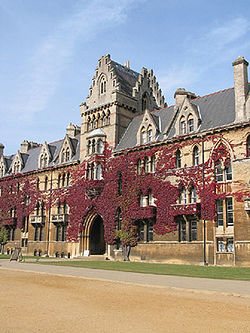This article needs additional citations for verification .(May 2014) |
| The Meadow Building | |
|---|---|
 | |
 | |
| General information | |
| Architectural style | Venetian |
| Address | St Aldate's, Oxfordshire, England |
| Coordinates | 51°44′58″N1°15′16″W / 51.749444°N 1.254444°W |
| Year(s) built | 1862–66 |
| Design and construction | |
| Architect(s) | Thomas Deane |
Listed Building – Grade II | |
| Official name | Christchurch, Meadow Buildings |
| Designated | 29 January 1968 |
| Reference no. | 1198863 |
The Meadow Building (known as "Meadows" to students, aka Meadow Buildings [1] ) is part of Christ Church, Oxford, England, one of the Oxford colleges, looking out south onto Christ Church Meadow on Broad Walk and then along the straight tree-lined Poplar Walk to the River Thames.
Contents
The building is used as the public entrance for paying visitors to Christ Church instead of the main entrance under Tom Tower in St Aldate's. [2]





